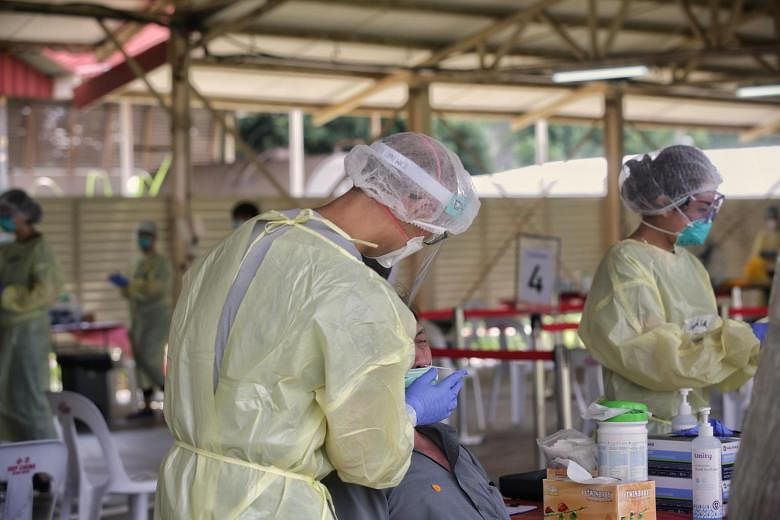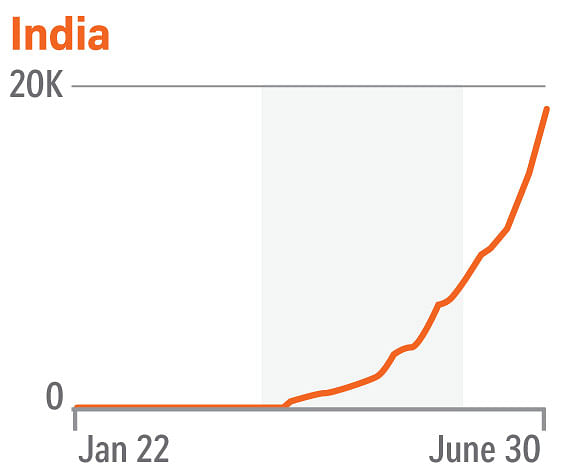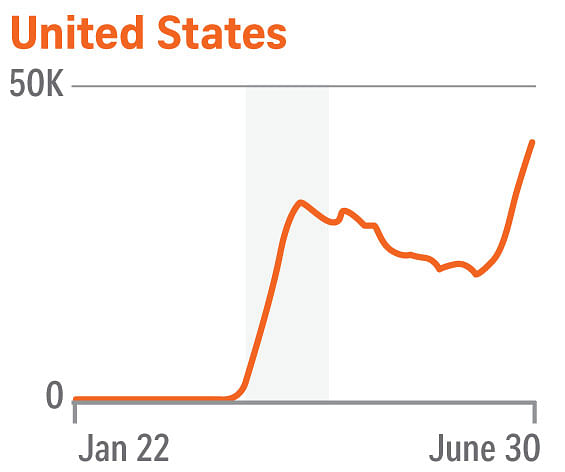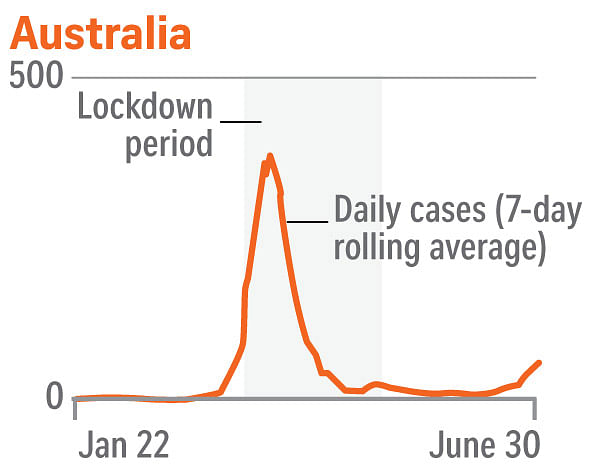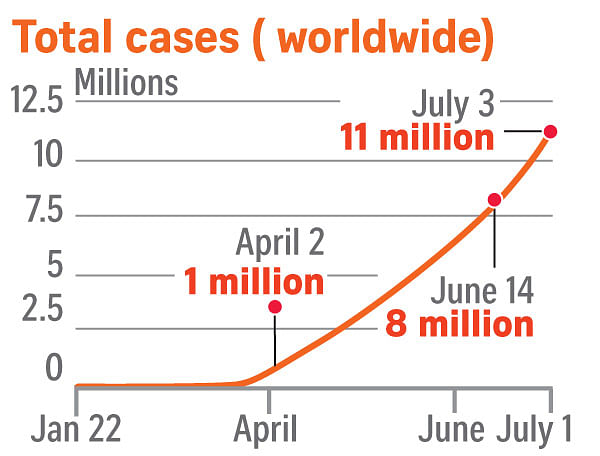Instead of things getting better, as might be expected with greater understanding of the coronavirus, the Covid-19 pandemic has gone from bad to worse.
In May, 2.8 million people around the world were infected with the virus. Last month, the number was 4.4 million people. Another 600,000 people became infected in the first four days of this month.
And the experience of countries, such as South Korea and Vietnam, that have been able to bring down or even stop the spread of infection, shows that the pandemic can be contained, perhaps even halted, but unfortunately at a great cost to the economy.
What is known is that the virus is largely spread from person to person, and also by people who show no symptoms. Incubation is generally about five days, but could take as long as a fortnight. So if everyone stayed isolated for a month, those infected would not spread it to others.
The theory is simple. The practice is near impossible.
The Covid-19 outbreak in foreign worker dormitories here - which started in March but is still spreading today and has infected more than 42,000 people - shows how difficult it is to stop the spread even within a confined group.
What more an entire population.
This is especially so when essential services must continue even in the face of a deadly pandemic.
What many countries in Asia and Europe have managed to do is to flatten the curve - or reduce the number of cases so that healthcare systems are not overwhelmed and patients can be better managed.
But for some countries, this has taken a while to achieve.
Weeks, or even months, of lockdown were required, where most people were confined to homes and non-essential businesses closed.
But lockdowns cannot go on indefinitely. And the results of such lockdowns have not been uniformly successful.
Professor Euston Quah, director of Nanyang Technological University's Economic Growth Centre, said: "From an economics point of view, it is inevitable that we have to consider reopening the economy, as each day we continue to close the economy costs us billions of forgone opportunities and business lost.
"This in turn means jobs threatened and some lost.
"The multiplier effect will further make it worse from reduced spending and hence affecting the retail and consumption sector as well."
A responsible government has to consider seriously the trade-off between increased infections and potential fatalities in opening up the economy, and the significant losses in jobs and incomes, he said.
Dr Asok Kurup, an infectious diseases expert in private practice, said countries can ease restrictions if community transmission is manageable and measures are in place to scale up.
"The problem is that easing occurred in many settings without these requirements being met," he said. Examples include Brazil, Russia and Mexico.
Another infectious diseases expert, Professor Dale Fisher of the National University Hospital, said some countries were clearly "bowing to economic, social and political pressures".
He said: "The main point of a lockdown was to allow a tightening of the outbreak response in terms of contact tracing, testing, isolation capacity, etc. Countries that did not take advantage of the lockdown period will inevitably see transmissions return."
Lockdowns in some countries did not flatten the infection's growth curve, Prof Fisher said. Countries in the Americas, India and Indonesia "have challenges with their large populations and community infrastructure", he said. These are places that are experiencing an increasing number of cases.
Professor Teo Yik Ying, dean of the NUS Saw Swee Hock School of Public Health, said the majority of the new daily cases are coming from the United States, Brazil, India, countries in Latin America, the Middle East and South Asia.
He said: "The majority of these countries did indeed relax their restrictions before community transmissions were brought under control."
In some of these countries, large segments of the population receive daily or weekly wages, and livelihoods were badly affected due to extended lockdowns.
He added: "So it was a difficult compromise between relaxing the restrictions to allow people to return to making a living, and maintaining the lockdown but seeing large swaths of the population suffer from economic hardship.
"Many of these governments actually decided it was necessary to open up the economy again to avoid the certainty of mass poverty and hunger that comes with extended lockdowns."
India, for example, has had limited success with its lockdown, given its large number of poor people who needed work to survive. Infection numbers have been soaring since May, overwhelming healthcare facilities in some cities. More than 20,000 new infections are reported every day, as well as a few hundred deaths. Maharashtra, the state which includes the country's largest city, the densely populated Mumbai, is the worst hit.
But there are also countries rich enough "to support their people through an extended lockdown to truly get the situation under control, but failed to do so", said Prof Teo.
He did not name any country, but the US is obviously one, with more than 50,000 new cases diagnosed every day, and hundreds of deaths.
Lockdowns and the easing of restrictions there varied from state to state. More than a quarter of all Covid-19 infections, and deaths, in the world have occurred in the US.
Some worrying uptrends have appeared in countries such as China, Japan and South Korea that seemed to have had the outbreak under control. However, experts said that while the number of cases might have gone up recently, the countries are not facing out-of-control spread of the virus, given their rapid identification and isolation of close contacts.
Prof Fisher said South Korea "has quite consistent numbers suggesting that they have it under control". It still has new cases, but the daily number is less than 100.
In Japan, cases have been going up in the past fortnight, with 194 new cases reported on Friday, most of them in its capital, Tokyo.
Associate Professor Hsu Li Yang, an infectious diseases expert at the School of Public Health, said cases in these countries do not indicate the start of a second wave of infections.
Experts have been warning of the possibility of a second surge of cases in countries that have brought infection rates down and have since eased restrictions. Such a second wave could potentially be worse than the first.
Prof Hsu said a second wave may be occurring in Iran, where the number of cases has risen.
Iran, one of the worst-hit countries in the early days of the pandemic, had brought the number of cases from more than 3,000 a day at the end of March to under 1,000 a day by early May. Restrictions on public events and travel between cities were imposed in March and gradually eased in April. But cases started to surge in early June and now stand between 2,000 and 3,500 a day.
More than 100 countries around the world have fewer than 20 new cases a day. Another 50 or so have fewer than 200 new cases a day.
Yet all of them are being affected by surging infections in other parts of the world.
International travel for leisure has come to a complete stop. Unemployment has been climbing. Global economies have shrunk.
But the experts said there is no reason that countries doing well in containing the pandemic cannot resume trade and travel.
Said Prof Fisher: "Modified resumption of most activities can return safely, including international travel between countries that have a similar handle on their outbreak responses.
"Countries that can identify their hot spots, successfully quarantine their contacts, shut down transmission chains, could collaborate in travel without the need for testing and quarantining all travellers."
Prof Teo said countries that have overcome Covid-19 are already setting up "travel bubbles" and green lane arrangements for essential business travel. The majority of trade and businesses will resume to ensure supply chains are maintained.
"Sensible countries will continue to protect themselves by partnering only with countries that have similarly contained the outbreak, and excluding others that have not," he said.
So Sweden, which had implemented minimal restrictions, has been excluded from free travel within the Scandinavian bloc; and the European Union has said it does not welcome visitors from the US where the pandemic is still raging.
But he added: "I do not think it is prudent to allow widespread resumption of unconditional mass market tourism for most parts of the world."
It will be a long time before life goes back to normal.
Until a viable and readily available vaccine is developed - and this is not expected by this year - countries have to continue taking precautions against the import of the virus, or its spread locally.
There is also a question mark over whether such a vaccine would provide the longed-for solution.
Dr Kurup said such a vaccine "would be like manna from heaven", but there are more questions than answers at the moment.
These include how effective the vaccine is, whether it works as well in older people - the ones most affected by this coronavirus - how long it remains effective, and whether enough can be produced for everyone who needs it.
Prof Teo said a vaccine that is only partially effective will result in people still being infected despite having been vaccinated, and thus the virus continues to circulate.
Dr Kurup expects community cases in Singapore to inch up but hopefully not enough to stretch resources. "In other words, we will likely be living with Covid for the foreseeable future."
Community cases in Singapore have doubled from an average of four cases a day in the first week of phase two of reopening on June 19, to eight cases a day in the past week. There were nine cases yesterday.
Prof Hsu agreed that life will not go back to normal "short of an extremely effective vaccine, eradication of Sars-CoV-2, or attenuation of viral virulence, all of which are unlikely events over the next one to two years".
He added: "I would expect masks and physical distancing practices, including working from home for those who can, to be very much the norm, even as measures are relaxed further with regard to social interactions and travel.
"Things will almost certainly not revert to the pre-Covid-19 era by the end of 2021."

